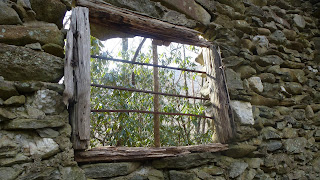Keyhole Rock
photo credit: Matt Perry
Today's hike is a shuttle, beginning near the Danbury water tower heading up to Sheep Rock and continuing to the Hanging Rock and the park's visitor center. We are a group of 13 from the Friends of Sauratown Mountains group. Except for the last mile, the hike is entirely on unmaintained trails or off trail.
Our first task is to gain enough elevation to attain the top of the ridge I call Hanging Rock Ridge. I consider the ridge to include Hanging Rock itself, the three Sisters and Sheep Rock.
Once we have attained the ridge and regrouped, our first stop is a rock ledge which provides a view of Keyhole Rock. You can scramble down to this keyhole but we have a long hike over undulating terrain today, so we stay on the top.
We stay on the top of the ridge as we make the long climb up Little Sister. I don't know the official names of these peaks. They are called the sisters. I have heard them called, First, Second and Third Sister. They are referenced in a newspaper article as Saura, Cheraw and Catawba which follows the plight of the Saura Indians which last occupied this area. Their group having been reduced in size, moved south to assimilate with others and be called the Cheraw. Shortly thereafter they moved west to do the same with the Catawba Indians. Nevertheless, I call the 3 peaks Little, Middle and Big Sister.
Our group splits apart on the long climb up Little Sister, so I ask Matt to take the lead group to the gap beyond Big Sister and visit the site of the plane wreck. My group slowly makes the climbs and descents of the Sisters. We are treated to views like the one above as we walk along the tops of the peaks.
Our arrival at the rendezvous spot is about 10 minutes before Matt's group arrives after visiting the plane wreck.
Once again the group splits on the climb up Hanging Rock Ridge. I never see the lead group again but receive a text saying they all made it back. Our group explores the cantilevered rock with the stealth campsite. This is always an amazing geological formation to visit.
Hikers slip through a hole in the rocks before leaving Hanging Rock Ridge.


















